#Virtual Reality Workforce Training
Explore tagged Tumblr posts
Text
As industries evolve, the need for effective training solutions becomes increasingly critical. Traditional training methods often fall short, especially in high-risk environments where practical experience is essential. Enter Simulanis, a pioneering company specializing in Virtual Reality (VR) solutions for industrial training. With its innovative approach, Simulanis is redefining how organizations train their employees, ensuring that they are well-equipped to handle the challenges of their respective fields
#virtualreality#simulanissolutions#augmentedreality#immersivelearning#learningbydoing#vrtraining#skilldevelopment#VR Industrial Training Solutions#Virtual Reality for Industrial Training#VR Training for Manufacturing#VR Safety Training#Industrial VR Simulations#VR for Equipment Training#Virtual Reality Training Programs#VR for Worker Training#Immersive VR Industrial Training#Virtual Reality for Hazard Training#Industrial Skill Development VR#VR for Maintenance Training#Virtual Reality Safety Simulations#VR Training for Heavy Machinery#Virtual Reality Workforce Training#AR/VR Industrial Solutions#Virtual Reality in Manufacturing Training#VR Training for Industrial Equipment#VR for Emergency Response Training#VR-Based Industrial Simulation
0 notes
Note
interesting how they think dark romance is "grooming" women into being abused meanwhile actual right wing figures are trying to ban both books and porn...dark romance and romantasy are not the problem y'all
Lol yeeeep
And the sad thing is, a lot of supposed left-wingers have fallen for the "save the children (women) from sexual content" argument hook, line, and sinker. They've pushed the neopuritanical wave just as much as right-wingers have, just in different packaging.
Don't get me wrong: Porn can be harmful. Any sexual content, like virtually any content of any kind, has the potential to be harmful. But the reality is that pornography of some sort has always existed and will always exist. Just like (a lot of, but not all) people have always enjoyed an element of voyeurism. People like looking at art depicting sex. They like reading about sex. They like watching people fuck. There's a point where you have to just chalk it up to human nature. Again: NOT ALL PEOPLE. But most. Probably the vast majority, when you strip away hangups and society. And that's not me erasing those who don't; you are valid and your needs should be accommodated, and I frankly think they.... often are. Especially in this cultural moment.
But it's okay to want to consume explicit content, whether it's because it turns you on or just because... because.
There are many reasons why people perceive a porn problem, but the root of all evils is not that content. It's how we as a society treat it, and, on a basicl level, how we as a society expect and encourage people to fucking parent their children.
I so often see people say "But I don't want my kids to read those books" "I don't want my kid to watch that".
Dude. They most likely will if they want to. Even if that content is banned—and I hope it isn't, but I'm bracing myself, and a good cluster of states in the US, including blue ones, have essentially banned porn through age verification laws—people will find a way to access it. Just as they found a way to access alcohol, and weed, and so on. People do find a way to access that content in countries that currently ban porn.
So the thing is—you can either bury your head under the sand and train people to become weird about it... or you can have honest conversations and encourage healthy consumption. My mom told me that there was a difference between porn and reality. My mom read romance novels with me to get an idea of how I was consuming them (and it was fun, because I was lucky and had a pretty cool mom, overall).
And it bums me out, frankly, to see so many women act as if the "pornifiation of society" is what's keeping women down, versus the MUCH MORE PRESENT issues of like... the wage gap. Poor childcare options. The encouragement of the idea that having children is what you're meant for if you're born with a uterus. People trying to rape us all the time, which they ALWAYS HAVE, that's not porn! Red pilling, which is not a porn thing (a lot of red pills eschew porn!). Systemic racism and transphobia, which hits women of color and trans women, and as long as they don't have equal rights, women will not have equal rights.
Dark romance is not leading women down the tradwife lifestyle. You know what is? Christian indoctrination linking up to the crunchy granola girl pipeline. The mass spread of conspiracy theories and the twisting of gender essentialist "I know my body and therefore that of my child better than any dooooctooooor" bullshit that push the idea that you're this Earth Mother and not a normal human being. Not to mention a shitty economy, all those factors relating to women in the workforce I mentioned above, utilized to further push the idea that it would be soooo much easier if you just stayed at home with your babies. And then we throw in the dismantling of the public education system, which is only getting WORSE..... People are just less educated, and they want women to be less educated than men, and that has a LOT going on that has nothing to do with the dark romances women read.
And these people would probably be better able to think critically if not for those issues, so.
#romance novel blogging#another fun fact about my childhood is that i was homeschooled off and on#but it had nothing to do with religion; nope#my mom homeschooled us sometimes bc my dad moved us fucking everywhere and sometimes the school districts were horrid#and my mother had a degree in early childhood development and was in fact... a teacher#so she taught us! and she taught us well! and so much of our education was based in reading#and you know i thank her for it but i also sometimes wish i was less plugged in bc damn it's rough sometimes
16 notes
·
View notes
Text
Keys to the Digital Future
The digital future is not merely a continuation of today’s technological trends; it is a transformative landscape where innovation, connectivity, and sustainability intertwine to redefine how we live, work, and interact. As we step into this exciting future, understanding its essential components can empower individuals, businesses, and societies to thrive. Here are the key elements shaping the digital future:
Artificial Intelligence (AI) and Machine Learning (ML)
AI and ML are at the forefront of the digital transformation. These technologies are driving advancements in automation, data analysis, and decision-making. From personalized recommendations to autonomous vehicles, AI’s capabilities are reshaping industries. The future lies in ethical AI development, ensuring these tools enhance human lives while minimizing biases and risks.
The Internet of Things (IoT)
The IoT connects devices, systems, and people, creating an ecosystem of interconnectivity. Smart homes, wearables, and industrial IoT solutions are just the beginning. As 5G and edge computing mature, IoT’s potential to streamline operations and improve efficiency will expand exponentially, transforming everything from healthcare to urban planning.
3. Sustainable Technologies
The digital future must align with global sustainability goals. Renewable energy, energy-efficient data centers, and green computing practices are essential for reducing the environmental footprint of technology. The circular economy, which emphasizes recycling and repurposing electronic waste, will play a significant role in creating a sustainable digital ecosystem.
Cybersecurity and Privacy
As technology evolves, so do the threats associated with it. Cybersecurity is a cornerstone of the digital future, requiring robust frameworks to protect data and infrastructure. Privacy-centric technologies, such as blockchain and zero-knowledge proofs, offer innovative ways to safeguard user data and build trust in digital systems.
Digital Inclusion and Accessibility
A truly transformative digital future is one that is inclusive and accessible to all. Bridging the digital divide requires investments in infrastructure, affordable devices, and digital literacy programs. Technologies must be designed with accessibility in mind, ensuring equitable opportunities for everyone, regardless of location, ability, or socioeconomic status.
Quantum Computing
Quantum computing has the potential to solve problems that are currently beyond the reach of classical computers. By leveraging quantum mechanics, these machines can revolutionize fields such as cryptography, drug discovery, and climate modeling. While still in its infancy, quantum computing is a critical component of the digital frontier.
The Metaverse and Virtual Realities
The metaverse represents the convergence of physical and digital realities. Virtual and augmented reality technologies are enabling new ways of interaction, education, and entertainment. Businesses are leveraging these immersive environments for training, product design, and customer engagement, laying the foundation for a blended digital-physical world.
Ethical Leadership in Technology
The digital future demands leaders who prioritize ethics and societal well-being. From addressing algorithmic biases to ensuring responsible AI deployment, ethical leadership is crucial for fostering innovation that aligns with human values. Transparency, accountability, and collaboration will be key to navigating complex ethical challenges.
Education and Lifelong Learning
As technology evolves, so must our skills. The future workforce will require adaptability and continuous learning to keep pace with new tools and paradigms. Education systems must evolve to emphasize digital literacy, critical thinking, and collaboration, preparing individuals for the demands of a rapidly changing digital landscape.
Global Collaboration
The digital future is a global endeavor, requiring collaboration across borders, industries, and disciplines. Shared goals, such as mitigating climate change and advancing healthcare, necessitate partnerships that leverage collective expertise and resources. International cooperation will ensure that technological advancements benefit humanity as a whole.
The keys to the digital future lie in innovation, inclusivity, and sustainability. By embracing these principles and addressing the challenges they present, we can unlock unprecedented opportunities for growth and prosperity. As we navigate this dynamic journey, the digital future promises to be a realm of endless possibilities, limited only by our imagination and commitment to shaping it responsibly.
2 notes
·
View notes
Text
Rajasthan Launches AVGC-XR Policy 2024: A Step Toward Transforming the State’s Digital and Creative Industries

In a bold move to foster innovation and boost the state’s economy, the Rajasthan government recently launched the AVGC-XR Policy 2024. This policy aims to position Rajasthan as a leader in the rapidly growing sectors of Animation, Visual Effects, Gaming, and Comics (AVGC), as well as Extended Reality (XR). With the launch of this policy, Rajasthan is setting its sights on becoming a key hub for digital entertainment, immersive technology, and creative industries.
What is the AVGC-XR Policy 2024?
The AVGC-XR Policy 2024 is a strategic initiative by the Rajasthan government to promote the development of the AVGC and XR sectors in the state. It aims to create a sustainable and dynamic ecosystem that supports the growth of digital entertainment, gaming, animation, visual effects, and immersive technologies like virtual reality (VR) and augmented reality (AR). By leveraging the increasing demand for digital content and XR experiences, the policy seeks to establish Rajasthan as a global player in the creative and technology-driven industries.
This policy introduces several measures to support businesses, encourage talent development, and create a vibrant ecosystem for innovation and entrepreneurship. By fostering these industries, the Rajasthan government aims to boost employment, attract investments, and enhance the state’s global visibility in the digital world.
Key Features of the AVGC-XR Policy 2024
Financial Support and Incentives for AVGC and XR Companies The policy offers financial incentives for businesses operating in the AVGC and XR sectors. This includes subsidies, tax exemptions, and financial assistance to help businesses establish themselves and grow in the state. The policy also provides funding for startups involved in creating content, technology solutions, and other digital products in these sectors. These incentives will significantly reduce the initial investment burden on businesses, encouraging them to innovate and expand.
Skill Development and Talent Pool Creation One of the most crucial aspects of the AVGC-XR Policy 2024 is its focus on skill development. The policy recognizes the importance of a skilled workforce in driving the growth of the AVGC and XR industries. It proposes the establishment of training institutes and skill development programs specifically designed for animation, gaming, visual effects, XR technologies, and other digital content creation fields.
By investing in skill development, the government hopes to create a large pool of talent that can meet the growing demands of the industry. This will also ensure that Rajasthan becomes a talent hub for the national and international AVGC and XR sectors.
Infrastructure and Ecosystem Support The policy recognizes that the growth of the AVGC and XR industries requires robust infrastructure. To address this need, the Rajasthan government plans to develop dedicated clusters and innovation hubs for AVGC and XR businesses. These clusters will be equipped with the latest technology, high-speed internet, and collaborative workspaces that encourage innovation and creativity.
Additionally, the government will focus on creating a supportive ecosystem by collaborating with industry leaders, universities, and global players. This will help create an environment where companies can easily access resources, partnerships, and global markets.
Promotion of Rajasthan as a Global AVGC and XR Hub A significant goal of the AVGC-XR Policy 2024 is to make Rajasthan a global destination for the AVGC and XR industries. The policy outlines various strategies to promote the state’s capabilities in these sectors, including hosting international events, film festivals, and conferences. Rajasthan aims to attract global industry leaders, filmmakers, and content creators by offering them a conducive environment for collaboration, production, and innovation.
By leveraging the state’s rich cultural heritage and growing technological capabilities, Rajasthan plans to position itself as a leading center for digital content creation and immersive technologies.
How Will This Policy Benefit Rajasthan?
Job Creation and Economic Growth The AVGC-XR Policy 2024 is expected to generate significant employment opportunities in Rajasthan. By promoting industries such as animation, gaming, and visual effects, the state can create thousands of new jobs in creative fields, technology development, and digital content production. The policy will also encourage the growth of ancillary industries, such as software development, digital marketing, and content distribution, further boosting the state’s economy.
Attracting Investments and Global Partnerships With the implementation of this policy, Rajasthan is poised to attract both domestic and international investments in the AVGC and XR sectors. The incentives offered by the government will encourage investors and companies to establish operations in the state, which will bring in capital, expertise, and technological advancements. The policy’s focus on global partnerships will also help connect Rajasthan’s industries with the global market, creating new avenues for collaboration and growth.
Boosting Rajasthan’s Global Presence in the Digital and Creative Sectors The policy will put Rajasthan on the map as a hub for digital entertainment and immersive technology. Through various promotional strategies, including international events, film festivals, and business partnerships, the state will enhance its visibility in the global digital and creative industries. This increased global presence will attract global talent, increase tourism, and further promote Rajasthan’s cultural and technological strengths.
Fostering Innovation and Entrepreneurship The AVGC-XR Policy 2024 will encourage innovation and entrepreneurship in the state by providing financial support, infrastructure, and a collaborative ecosystem for startups. The government’s focus on creating innovation hubs will foster a culture of creativity and technology-driven entrepreneurship, enabling businesses to experiment, innovate, and grow.
The Future of Rajasthan’s AVGC and XR Industries
With the launch of the AVGC-XR Policy 2024, Rajasthan is set to become a major player in the digital entertainment and XR sectors. By investing in infrastructure, skill development, financial support, and global partnerships, the state is creating a conducive environment for businesses to flourish. The policy aligns with the growing global demand for digital content, animation, gaming, and immersive experiences, positioning Rajasthan as a key contributor to this dynamic sector.
As the world continues to embrace digital technologies and immersive experiences, the AVGC-XR Policy 2024 will provide Rajasthan’s businesses with the tools and resources needed to thrive in these fast-evolving industries. Whether you are an entrepreneur, investor, or creative professional, the policy offers numerous opportunities for growth, innovation, and success.
The AVGC-XR Policy 2024 is a significant milestone for Rajasthan in its journey to become a global leader in digital content creation and immersive technologies. With its comprehensive approach to infrastructure, talent development, financial support, and global promotion, the policy is set to revolutionize the AVGC and XR sectors in the state. For businesses and individuals in these industries, Rajasthan offers an exciting future full of opportunities to innovate, collaborate, and succeed in the global marketplace.
As the state continues to build on its strengths, the AVGC-XR Policy 2024 will undoubtedly help Rajasthan carve out a prominent place on the global digital map.
3 notes
·
View notes
Text
The Conscript Nurse Lifestyle

is a carefully structured and standardized approach to nursing that aims to create a cohesive, disciplined, and efficient workforce of healthcare professionals. Consisting of various elements, this lifestyle emphasizes androgynous presentation, professional grooming, and uniformity among nurses to foster a sense of unity and dedication to patient care.

Key aspects of the Conscript Nurse Lifestyle include:
Androgynous Presentation: Nurses undergo special training and grooming to achieve an androgynous appearance. This involves shaving their heads, weight loss, toning their bodies to become lean, and utilizing cosmetics and skincare to maintain a uniform, polished look.
Uniform: Consistent with the androgynous presentation, nurses wear a standardized, one-piece white uniform. The uniform is designed to symbolize professionalism, cleanliness, and dedication to their role.
Alpha Numeric Designators: Instead of using traditional names, nurses are assigned non-gendered alpha numeric designators. This measure is implemented to protect patient privacy and foster a professional environment while promoting a sense of unity among the nursing staff.
Specialized Training: Nurses undergo rigorous training, including neuro-psychological programming and virtual reality-based simulations, to enhance their skills, adaptability, and decision-making abilities. This ensures they are well-prepared to handle a wide range of medical situations efficiently.
Disciplined Lifestyle: Nurses adhere to a disciplined lifestyle, including regular physical fitness routines, adherence to strict diets, and weekly reinforcement sessions. These practices are designed to maintain peak physical and mental performance, as well as reinforce the commitment to their profession.
Chastity Devices: Similar to other conscripted roles, the Conscript Nurse Lifestyle involves wearing chastity devices during duty hours to maintain focus on patient care and professional boundaries.
Adherence to Protocols: Conscript nurses are expected to strictly adhere to established healthcare protocols and standardized procedures, ensuring consistency and precision in their care delivery
Restricted Personal Freedom: During their conscript service, nurses may experience limited personal freedom due to strict protocols and regulations. They may be prohibited from pursuing certain recreational activities or having unregulated social interactions to maintain focus on their duties.
Communal Living: Conscript nurses may live in communal dormitory-style accommodations provided by the nursing corps. This living arrangement fosters camaraderie and unity among the nursing staff.
Restricted Mobility: While on duty, conscript nurses' movements may be closely monitored and restricted to ensure prompt responses to patient needs and maintain a disciplined work environment.
Performance Evaluation: Conscript nurses are subject to regular performance evaluations to ensure compliance with established standards and protocols. Positive performance is often rewarded with recognition and privileges within the corps.

19 notes
·
View notes
Text
VR Training
Enhance workforce capability with Nexefy’s cutting-edge VR training solutions. Deliver realistic, immersive simulations that improve knowledge retention, safety, and skills application across industries. Perfect for enterprises and RTOs aiming for impactful, scalable learning experiences through virtual reality technology.
1 note
·
View note
Text
Training for Precision: The Benefits of VR for Quality Assurance in Manufacturing
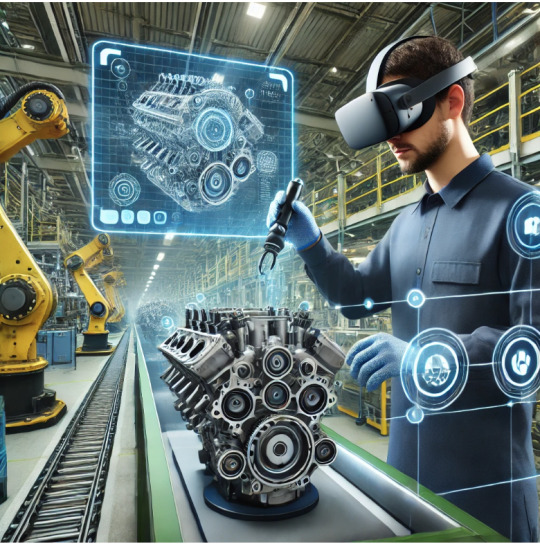
In the manufacturing industry, precision is key. A slight deviation in quality can result in defective products, wasted resources, and lost customer trust. This is where VR training comes into play. Leveraging virtual reality technology, companies can enhance quality assurance (QA) processes, improve workforce skills, and ensure consistency in production standards.
The Role of VR Training in Quality Assurance
Quality assurance requires meticulous attention to detail, consistency, and a deep understanding of production standards. Traditional training methods, such as classroom sessions or on-site mentoring, often struggle to deliver hands-on experience without the risk of damaging equipment or wasting materials.
VR training bridges this gap by providing immersive, risk-free environments where employees can learn and practice QA procedures. From detecting product defects to mastering the use of precision tools, VR training ensures employees are well-prepared before stepping onto the shop floor.
Key Benefits of VR Training Simulations for QA in Manufacturing
1. Enhanced Skill Development
Using VR training simulations, workers can interact with virtual models of machinery and products. They can practice identifying faults, performing inspections, or calibrating instruments with real-time feedback. This hands-on learning experience boosts skill retention and accelerates proficiency.
2. Standardized Training Across Teams
Manufacturing facilities often have multiple teams working across different shifts or locations. VR training solutions provide standardized content, ensuring all employees receive the same level of training, regardless of their location. This uniformity reduces variability and enhances overall QA processes.
3. Error Reduction
Mistakes in QA can lead to costly recalls or production halts. VR simulations allow employees to repeatedly practice complex QA tasks in a virtual environment until they perfect them. This reduces on-the-job errors and ensures higher accuracy in inspections.
4. Cost-Efficient Training
Traditional QA training often involves downtime, material wastage, and instructor fees. By adopting VR training solutions, companies can cut these costs while delivering highly effective, scalable training programs.
5. Real-Time Data and Analytics
One of the standout features of VR training is its ability to track employee performance in real time. Analytics from training sessions highlight areas where workers excel and areas that need improvement, enabling tailored training approaches.
Conclusion
In the quest for precision and quality, VR training emerges as a powerful tool for manufacturing industries. By providing immersive, scalable, and cost-effective training environments, virtual reality equips employees with the skills and confidence to excel in quality assurance.
With companies like DevDen leading the way in creating innovative vr development, the adoption of VR training is set to redefine standards in manufacturing QA. It’s time to embrace this cutting-edge technology to ensure precision, enhance productivity, and stay ahead in the competitive manufacturing landscape.
#3d product modeling#vr training solution#vr training#mixed reality#virtual reality#metaverse#augmented reality
0 notes
Text
AR or VR in Nuclear Power Plant Market - Forecast (2025 – 2030)
AR/VR in Nuclear Power Plant Market was valued at USD 8.8 billion in 2024 and is projected to reach a market size of USD 14.04 billion by the end of 2030. Over the forecast period of 2025-2030, the market is projected to grow at a CAGR of 9.8%.
The integration of Augmented Reality (AR) and Virtual Reality (VR) technologies in nuclear power plant operations represents a transformative shift in how these critical facilities are designed, operated, maintained, and decommissioned. As of 2024, the AR/VR in Nuclear Power Plant market has emerged as a specialized but rapidly expanding segment within industrial AR/VR applications, driven by the nuclear industry's pressing needs for enhanced safety protocols, operational efficiency, and workforce development solutions. These immersive technologies enable nuclear operators to visualize complex systems, simulate hazardous environments, and train personnel without exposure to radiation or operational risks. The nuclear power industry faces unique challenges including aging infrastructure, stringent regulatory compliance requirements, and the need to preserve institutional knowledge as experienced workers retire. AR/VR technologies address these challenges by creating digital twins of facilities, allowing for remote inspection and maintenance planning, and providing immersive training experiences that significantly reduce the learning curve for new personnel.
Download Sample
Key Market Insights:
Industry surveys indicate that nuclear operators implementing AR/VR technologies have reported average maintenance time reductions of 28%, while safety incident rates have decreased by 35% in facilities utilizing these immersive training solutions.
Training costs have been reduced by an average of 31% when compared to traditional methods, with knowledge retention rates improving by 76% according to comparative assessments.
Investment in AR hardware specifically designed for nuclear environments has grown by 67% over the previous year, while VR-based simulation platforms have seen a 52% increase in deployment across training centers.
Nuclear industry spending on AR/VR solutions represents approximately 8.3% of total digital transformation budgets, with 72% of nuclear operators planning to increase this allocation within the next 18 months. Market Drivers:
Enhanced Safety and Risk Reduction
Safety considerations dominate decision-making in nuclear operations, creating a powerful driver for AR/VR adoption. These technologies enable personnel to train for high-risk scenarios without exposure to actual hazards, significantly reducing the potential for accidents and radiation exposure. Through immersive simulations, operators can practice emergency procedures repeatedly until achieving mastery, something impossible in live environments. AR overlays provide real-time radiation mapping and critical system status information directly in workers' field of vision, reducing cognitive load and minimizing error potential during complex tasks. Nuclear facilities implementing AR-guided maintenance procedures report substantial reductions in human error rates and near-miss incidents. The ability to rehearse complex operations virtually before executing them in radiation areas has demonstrably reduced collective radiation dose to maintenance crews. As regulatory bodies increasingly recognize the safety benefits, some have begun offering compliance incentives for facilities adopting these technologies as part of comprehensive safety programs, further accelerating market growth.
Buy Now
Workforce Challenges and Knowledge Transfer
The nuclear industry faces a significant demographic challenge as experienced operators and technicians retire, taking decades of institutional knowledge with them. AR/VR technologies provide powerful solutions for capturing, preserving, and transferring this critical expertise to new generations of workers. Virtual environments allow seasoned professionals to record detailed procedures and insights, creating immersive training experiences that new employees can access repeatedly. This knowledge capture is particularly valuable for rare procedures or emergency responses that might otherwise take years of experience to master. The accelerated training capabilities of VR systems enable new technicians to achieve competency in complex tasks 40-60% faster than traditional methods. Furthermore, AR systems provide real-time guidance during actual work execution, allowing less experienced personnel to perform complex tasks with expert-level precision. As nuclear operators worldwide face recruitment challenges, the appeal of working with cutting-edge technology has proven effective in attracting tech-savvy younger workers to the industry, addressing persistent talent acquisition challenges.
Market Restraints and Challenges:
Despite promising benefits, the AR/VR nuclear market faces significant hurdles including high initial implementation costs, averaging $3-5 million for comprehensive deployment at a single facility. Regulatory approval processes remain lengthy and complex, with cybersecurity concerns presenting particular challenges as these technologies interface with critical systems. Hardware durability in radiation environments requires specialized development, while integration with legacy control systems dating back decades presents technical incompatibilities that limit functionality in older facilities.
Market Opportunities:
The decommissioning segment presents substantial opportunities as approximately 100 nuclear reactors worldwide are scheduled for retirement by 2035. AR/VR technologies can significantly reduce radiation exposure and improve efficiency during these complex projects. Additionally, small modular reactor (SMR) developers are integrating AR/VR from initial design phases, creating opportunities for technology providers to establish standards in this emerging sector. The growing emphasis on extending existing plant lifespans creates demand for advanced maintenance solutions that AR/VR uniquely addresses.
Market Segmentation:
Segmentation by Technology Type:
• Augmented Reality (AR) • Virtual Reality (VR) • Mixed Reality (MR) • Digital Twin Integration • Extended Reality (XR)
Virtual Reality commands 48% of the market share due to its established presence in training applications. VR simulation environments allow for comprehensive recreations of entire plant systems and emergency scenarios without radiation exposure. The technology's maturity and proven ROI in training applications have made it the foundation of most nuclear facilities' immersive technology programs, with particularly strong adoption in operator certification programs.
Mixed Reality is experiencing 87% year-over-year growth as it combines the strengths of both AR and VR technologies. MR platforms enable technicians to interact with virtual components while maintaining awareness of the physical environment, making them ideal for complex maintenance procedures. The ability to simultaneously view digital information while manipulating physical components addresses unique challenges in nuclear applications, particularly in retrofitting older facilities with digital capabilities.
Enquire Before Buying
Segmentation by Application:
• Training and Simulation • Maintenance and Repairs • Radiation Visualization • Remote Operations • Design and Planning • Decommissioning Support
Training and Simulation applications represent 52% of the market as nuclear operators prioritize workforce development. The ability to create realistic training scenarios without radiation exposure offers immediate safety benefits and measurable cost reductions. Nuclear regulatory bodies in major markets have formally recognized VR-based training programs as valid components of operator certification, cementing this application's dominance in the market landscape.
Decommissioning Support applications are growing at 93% annually as nuclear facilities reach end-of-life worldwide. AR/VR technologies enable precise planning and execution of complex dismantling procedures while minimizing radiation exposure. The ability to rehearse decontamination sequences virtually before execution significantly reduces project timelines and waste volumes, creating compelling financial incentives for implementation in this high-cost phase of the nuclear lifecycle.
Segmentation by Component:
• Hardware (Headsets/Displays) • Software Platforms • Content Development • Integration Services • Maintenance and Support
Software Platforms account for 45% of market revenue due to their central role in creating and delivering nuclear-specific applications. These platforms require specialized development to meet nuclear industry requirements for reliability, security, and integration with existing systems. The recurring revenue model of software licensing and updates provides stable income streams for providers, making this the most profitable segment within the market.
Hardware specifically designed for nuclear environments is growing at 75% annually as manufacturers address unique industry requirements. Radiation-hardened devices capable of operating in high-radiation zones represent a specialized niche with premium pricing. Recent innovations in lightweight, hands-free AR displays that can be worn with existing safety equipment have driven rapid adoption among maintenance teams seeking productivity improvements.
Segmentation by End User:
• Nuclear Power Utilities • Research Reactors • Nuclear Equipment Manufacturers • Regulatory Bodies • Training Institutions • Decommissioning Contractors
#AR or VR in Nuclear Power Plant Market#AR or VR in Nuclear Power Plant#AR or VR#Nuclear Power Plant Market#nuclear power plant#power
0 notes
Text
Augmented Reality Market Size, Share, Analysis, Forecast, Growth 2032: Software Segment Expected to Outpace Hardware
The Augmented Reality Market was valued at USD 81.5 Billion in 2023 and is expected to reach USD 1364.9 Billion by 2032, growing at a CAGR of 36.80% from 2024-2032.
The Augmented Reality (AR) market has swiftly evolved from a niche technology into a transformative force across various industries. From gaming and retail to healthcare and manufacturing, AR is enabling immersive experiences that enhance user engagement and streamline operations. As businesses prioritize digital transformation, the integration of AR solutions is becoming a strategic imperative, driving innovation and reshaping how consumers and enterprises interact with the digital world.
Augmented Reality Market Accelerated by advancements in mobile technology, 5G networks, and AI integration, the AR market is experiencing heightened momentum. Enterprises are investing in AR for training, remote collaboration, product visualization, and customer engagement. The growing demand for contactless interfaces and enhanced remote support has further fueled the adoption of AR, making it a core element of modern digital strategies.
Get Sample Copy of This Report: https://www.snsinsider.com/sample-request/5872
Market Keyplayers:
Microsoft – HoloLens 2
Meta (formerly Facebook) – Meta Quest 3
Apple – Vision Pro
Google – Google ARCore
Snap Inc. – Spectacles AR
Magic Leap – Magic Leap 2
Niantic – Pokémon GO
Vuzix – Vuzix Blade
Epson – Moverio BT-40S
Lenovo – ThinkReality A3
Pimax – Pimax Crystal
Qualcomm – Snapdragon XR2
Sony – PlayStation VR2
PTC – Vuforia
Zebra Technologies – HD4000 Enterprise Headset
Market Analysis The AR market is characterized by dynamic growth driven by continuous innovation and increasing demand across consumer and enterprise sectors. Consumer applications are thriving in entertainment and e-commerce, while enterprise use cases focus on workforce training, real-time diagnostics, and immersive design. Major players are expanding their AR ecosystems by investing in both hardware and software development, while startups contribute agility and specialized solutions. The competitive landscape remains vibrant, with strategic collaborations, mergers, and acquisitions shaping future market dynamics.
Market Trends
Surge in AR-powered smart glasses and head-mounted displays across industries
Rising integration of AR with artificial intelligence for context-aware experiences
Growing use of AR in retail for virtual try-ons and interactive product demos
Expansion of AR applications in healthcare for surgical guidance and remote assistance
Emergence of WebAR enabling AR experiences without dedicated apps
Increased enterprise adoption for training, maintenance, and virtual prototyping
Advancements in AR cloud infrastructure supporting persistent and shared experiences
Market Scope The scope of the AR market spans across a wide range of verticals including healthcare, retail, education, automotive, real estate, and defense. Innovations are not limited to entertainment; they encompass serious applications such as therapy, design, logistics, and smart city planning. With continual hardware enhancements and software evolution, AR is seamlessly embedding into existing workflows and consumer lifestyles. This versatile applicability offers vast potential for stakeholders ranging from technology providers and content creators to service integrators and end users.
Market Forecast The AR market is poised for robust expansion, supported by continuous investments in R&D and favorable regulatory support. As user interfaces become more intuitive and affordable hardware becomes widespread, AR will transition from experimental stages to mainstream adoption. Educational institutions, retail brands, and industrial manufacturers are expected to be major contributors to this growth trajectory. Future developments in wearable devices and AR software platforms will further cement AR’s role as a key pillar of next-generation digital infrastructure.
Access Complete Report: https://www.snsinsider.com/reports/augmented-reality-market-5872
Conclusion The AR market is not just growing—it is redefining how we engage with technology. As immersive experiences become the new standard, organizations that embrace AR early will lead the charge into a digitally enriched future. From transforming industries to reshaping daily interactions, augmented reality stands as a beacon of innovation, promising limitless possibilities in an increasingly connected world.
About Us:
SNS Insider is one of the leading market research and consulting agencies that dominates the market research industry globally. Our company's aim is to give clients the knowledge they require in order to function in changing circumstances. In order to give you current, accurate market data, consumer insights, and opinions so that you can make decisions with confidence, we employ a variety of techniques, including surveys, video talks, and focus groups around the world.
Contact Us:
Jagney Dave - Vice President of Client Engagement
Phone: +1-315 636 4242 (US) | +44- 20 3290 5010 (UK)
0 notes
Text
Revolutionize Your Enterprise with Simulanis VR & AR
The future of business is immersive, interactive, and driven by technology. Enterprises that embrace Virtual Reality (VR) and Augmented Reality (AR) are unlocking new levels of efficiency, engagement, and innovation. At Simulanis, we are revolutionizing industries with cutting-edge VR and AR solutions that transform workforce training, customer experiences, and operational workflows.

Why VR & AR Are Essential for Enterprise Growth?
🔹 Next-Generation Employee Training Traditional training methods are no longer enough. Simulanis VR training solutions create realistic, hands-on virtual simulations, allowing employees to practice in a risk-free environment. AR-assisted learning further enhances training by providing real-time digital overlays and interactive guidance.
🔹 Enhanced Customer Engagement & Product Visualization Enterprises can showcase products and services in 3D, offering customers an immersive and interactive buying experience. VR-powered virtual showrooms and AR product visualization tools help businesses boost sales and brand loyalty.
🔹 Operational Efficiency & Safety Improvements From industrial safety training to real-time AR-powered remote assistance, immersive technologies help enterprises reduce risks, improve accuracy, and enhance productivity. AR smart glasses and VR simulations empower teams to perform complex tasks with greater precision.
🔹 Immersive Collaboration & Remote Work Solutions With VR-powered virtual workspaces, businesses can conduct meetings, training sessions, and brainstorming workshops in a realistic, collaborative digital environment. This is the future of hybrid work models and global enterprise connectivity.
🔹 Seamless Integration with the Metaverse The Metaverse is redefining business interaction, allowing enterprises to build virtual spaces, host digital events, and create next-level customer experiences. Simulanis provides tailored Metaverse solutions that help businesses stand out in the digital landscape.
Industries Benefiting from Simulanis VR & AR Solutions
✅ Manufacturing & Industrial Training – VR-based process training, equipment simulations, and AR maintenance guides. ✅ Healthcare & Medical Training – Surgical simulations, medical procedures training, and AR-assisted diagnostics. ✅ Retail & E-Commerce – Virtual try-ons, 3D product showcases, and interactive shopping experiences. ✅ Education & Corporate Learning – Engaging VR classrooms, AR-based learning modules, and enterprise e-learning solutions. ✅ Real Estate & Architecture – Immersive virtual property tours, 3D architectural visualizations, and interactive design planning. ✅ Automotive & Engineering – VR for vehicle prototyping, driver training, and AR-powered repair assistance.
Why Choose Simulanis?
At Simulanis, we are pioneers in VR, AR, and Metaverse technology, helping businesses unlock the full potential of immersive solutions. Our expertise in Extended Reality (XR) solutions ensures that enterprises can streamline operations, enhance customer engagement, and train employees more effectively.
🚀 The future of enterprise innovation starts now! 🚀
📩 Get in touch with Simulanis today and explore how VR & AR can transform your business!
Visit Website: simulanis.com
#Virtual Reality (VR)#Augmented Reality (AR)#Mixed Reality (MR)#Metaverse Solutions#Extended Reality (XR)#Enterprise VR Solutions#AR for Business#Immersive Technology#Future of Work#Digital Transformation#VR Training Programs#AR Training Modules#Industrial VR Training#Corporate Learning with XR#3D Virtual Simulations#AR Product Visualization#Workforce Training Solutions#Metaverse for Enterprises#Remote Work with VR#AI-Powered AR/VR#Smart Manufacturing with XR#VR for Employee Development#Augmented Reality for Retail#Virtual Showrooms#AR Maintenance & Support#VR in Healthcare & Medical Training#Immersive Learning Solutions#AR/VR for Real Estate#Enterprise Innovation with XR
0 notes
Text
Top Learning Trends for 2025 for Upskilling
Top Learning Trends for 2025 for Upskilling
The landscape of jobs is upgrading very quickly, thanks to the latest technological innovations and advancements. It also means that to stay relevant, you need to upgrade continuously. In other words, to stay competitive, professionals must acquire new skills, and 2025 is no exception. Since most workplaces are demanding the latest skills, upgrading has become dynamic. The modern world demands lifelong learning, not only to keep current but also for improved prospects and financial rewards, in contrast to the traditional idea of mastering one or two talents. There are several skills to acquire, each needing a different one. Life-long learning also means that you learn without quitting your job. And you can accomplish your goals with online master's programs. Here are a few of the skills you can develop:
AI-Powered Personalized Learning: With technology getting updated so quickly, it is not possible for one-size-fits-all. Moreover, different people have different styles of learning and may have different knowledge gaps. So personal learning that is tailor-made becomes a cakewalk if it’s AI-powered. Since it analyzes and then plans according to the learner’s strengths, weaknesses, and pace. This individualized training aids in improving the efficiency of professional development and identifying new, in-demand talents.
Learning with AR & VR: Augmented Reality (AR) and Virtual Reality (VR) is the latest trend in the year 2025. You must realize that AR overlays digital information in the physical world during on-the-job training to provide contextual guidance. Conversely, VR produces completely immersive simulations perfect for practicing high-stakes situations like customer engagement or for honing soft-skills like negotiating. These are important as they help professionals in engaging in virtual workplaces and in conducting interactive labs. In addition to that, these help in real-time collaborative environments.
Industry–Specific Skills: Generic training leads to generic jobs. You have to concentrate on acquiring the skills that are specific to the industry you are interested. To state it differently, sector-focused training ensures that you have job-relevant competencies, and because of your chances of creating a niche for your professional life. Even micro-credentials will enhance your chances exponentially. In short, as businesses demand new skills, professionals who embrace customized learning pave the way to the higher hierarchy in the corporate world.
Blended Learning for Hybrid Workforces: As the presence of the word “hybrid’ indicates, this is the combination of two-or more. Blended learning is a hybrid program where both online and offline modes of education are included for the maximum benefit of the learner. It offers both the flexibility and the personalized learning option. This has become the winning strategy for both companies and the employees who can upskill with little effort. Learning methods like micro-learning, e-learning, and/or live sessions help in boosting the quality of employees’ skills.
Micro-learning: In this digital age, everyone is busy and has little time to spare. Hence, the micro-learning concept became prominent in the year 2025. Most of these will be in five to ten minutes. You can learn a lot of new skills the quickest way possible in this way. This bite-sized learning content can be short videos, interactive quizzes, infographics, and even short challenges, and so on. The best part of these is that they can be consumed during short breaks and / or between tasks. Because of this, even companies are encouraging this mode of education.
Social Learning Networks: Social learning networks are the platforms that foster a collaborative learning environment and connect to the people who share their knowledge and expertise with others. This helps learners or employees to ask and discuss key points and various ideas on problem-solving. That’s why many companies are dedicating a platform for social learning networks, and these are used for peer-to-peer learning, mentorship, and the organic growth of expertise. In this way, they pave the path for a more adaptive workforce and get an edge over other companies.
Nano-degrees and Micro-Credentials: One of the top learning trends for 2025 in Nano-degrees and micro-credentials. These are very compact and specialized offerings to aspiring professionals who want focused expertise in topics like data science, digital marketing, project management, and so on. These offerings offer a flexible and scalable solution, enabling professionals to learn while balancing their work-life demands. Companies benefit from updating their employees, as it gives them a competitive advantage.
Peer-to-Peer Learning: A peer is someone with whom you can be very comfortable. Sharing becomes very easy. To state it differently, it is a collaborative approach that empowers employees to learn from one another. This also fosters a dynamic and engaging learning environment. It saves a lot of time and money for the businesses and builds rapport among the employees. Hence, many companies foster this culture, which is the greatest element of a future focused strategy.
Cyber-Security and Data Privacy: As the world is becoming highly digitalized, the demand for cyber-security and data privacy has increased exponentially. These areas are crucial for professionals who want to enter the digital world. They must maintain a robust defense system to stay ahead of attackers and ensure the safety of businesses’ data. Hence, updating knowledge on the latest cyber-security tools and data privacy protocols is a must for professionals who want to reach the top of the corporate ladder.
AI and Machine Learning: Artificial Intelligence and Machine Learning are rapidly transforming industries. All this is happening beyond our imagination. The need for intelligent automation and data-driven processes is driving a surge in demand for professionals with expertise in AI and ML. They are transforming sectors like healthcare, finance, retail, and defence. They make analyzing massive datasets and interpreting complex models very easy.
Emotional Intelligence & Leadership Training: In the advanced technology, human qualities like emotions and leadership play a crucial role. They are the essential competencies that help in career advancement and organizational success. Qualities like impersonal skills, empathy, effective communication, attentive listening, team-building, and self-awareness are essential for a high emotional quotient and effective leadership. To put it simply, stronger emotional intelligence and leadership qualities contribute significantly to both professional and financial growth.
After going through the above, you will understand that there is great scope for professional growth in the age of life-long learning. Though there are other modes of learning, online saves a lot of money and time besides being flexible. You can always accomplish your goals with online master’s programs. To conclude, rather than hesitating, take a course, be it a micro-learning or a full-fledged program, learn, and grow.
0 notes
Text
Timewarp TaskUs: The Future of Digital Outsourcing Excellence
The businesses are always seeking innovative solutions with scalability and operational efficiency through this fast pace of digital transformation. Enter Timewarp TaskUs, a new concept that is ushering in the futuristic revolution in outsourcing by fusing speed, groundbreaking technologies, and human-centric solutions to deliver stellar results. Here is what Timewarp TaskUs means, why this new age is threatening the existence of the BPO sector, and how it is revolutionizing the landscapes of customer experience and digital services.
What is Timewarp TaskUs?
Timewarp TaskUs is rapidly becoming known for being the next-generation strategy coveted by TaskUs, the world leader in providing digital outsourcing solutions. In a literal way, timewarp entails jumping enormously across time-into the future and transformative. When associated with TaskUs, it would mean the company actually bringing tomorrow's solutions today, thus allowing its customers to jump ahead in regards to customer digital experience, AI adoption, and operational excellence.
In reality, Timewarp TaskUs is a figurative model signifying:
Next-generation technology adoption at lightning speed
Futuristic customer care mechanisms
Smart process automation
Culture driven by employees to develop agile workforce
About TaskUs: A Brief Background
TaskUs was formed back in 2008 by Bryce Maddock and Jaspar Weir as a small virtual assistant company, and it has since grown into an industry giant with revenues in the billions and delivery centers around the world in places like the Philippines, India, and Mexico, among others. TaskUs provides outsourcing solutions for content moderation, customer experience, AI operations, and digital transformation.
Their awesomely simple purpose: To empower the world's most disruptive brands to create ridiculously good customer experiences.
Why "Timewarp" is the Ideal Metaphor for TaskUs
The term Timewarp is more than just a cute phrase-textualized metaphor; it actually embodies a whole future-thinking and hyper-agile strategy that TaskUs brings to every single client engagement. By which:-
1. Velocity and Agility at Scale
TaskUs is the specialist in hyper-growth settings. Whether it is helping a fintech startup or scaling content moderation for a social media giant, TaskUs will launch resources and strategies at breakneck speed-with shortening onboarding time, increased response time, and reduced friction.
2. Tech Going Into the Future
From AI moderation to cloud CRM solutions, TaskUs of course invests in a cutting tech stack. Adoption includes:
• Generative AI support bots
• Predictive analytics
• Machine learning for customer insight
• Automated quality assurance mechanisms
3. Human-Centric Culture in a Digital Age
Even as technology advances, the human element remains very strong in TaskUs. It invests in wellness programs and skill development and has quite a few mental well-being programs—a BPO that truly cares about its people.
Key Pillars of the Timewarp TaskUs Approach
Let's deconstruct the key pillars that symbolize the Timewarp TaskUs culture:
1. Hyperpersonalization
TaskUs totally phenomenon customer experiences through AI, data science, and behavior analytics.
2. Scalable Digital Transformation
The digital transformation of brands, smoothly balancing building legacy systems with cloud applications and manual processes with automation, designing static with adaptive processes.
3. Real-Time Support and Decision Making
TaskUs enables businesses to track KPIs through real-time dashboards and make fast changes to manage risks ahead of time.
4. Ethical AI and Moderation
TaskUs chronicle the industry in ethical AI training and human-in-the-loop moderation to keep digital communities safe against this world of misinformation and toxic content.
Why Businesses Need Platforms Like Timewarp
The Dynamic and fiercely competitive world of business today expects companies to provide world-class customer experiences while simultaneously scaling at a rapid rate and keeping up with ongoing changes. This is just where Timewarp TaskUs comes into the picture.
1. Need for Instant Solutions
Customers demand instant answers, real-time feed, and 24/7 support. Through AI-supported agents, automation, and 24X7 global support teams, Timewarp TaskUs assures businesses can deliver their promises.
2. Operational Complexity Increases
More digital touchpoints, multi-channel marketing, and global operations mean businesses need intelligent partners to ease operations. Timewarp TaskUs simplifies processes, integrate technologies, and provide flexible outsourcing models across evolving requirements.
3. Lack of Capable Talent
Finding and retaining the best talent, especially in special domains such as AI training, moderation, or multilingual support, proves difficult. TaskUs comes with trained mission-ready teams employing a balance of insight and empathy.
4. Scalable Innovation
Innovation needs to move fast and needs to be scalable. TaskUs gives companies the opportunity to pilot, test, and scale new technologies without extrapolating on internal resources and timelines.
5. Cost Optimization without Compromise
Timewarp-like platforms can provide best service, optimized for price- cutting back on overheads though an improvement on quality. Companies achieve efficiency without compromised quality.
6. Risk Management and Compliance
With a slew of regulatory authorities in the financial world, healthcare, and social media domain, it is of utmost importance that a company must comply with any such regulations. TaskUs ensures that data remains private, the AI is used ethically, and safety is measured on all ends for both users and enterprises.
Timewarp in Action: Real-World Examples
1. Global eCommerce Support
An internet giant used TaskUs to exponentially scale multilingual support across geographies. Advanced NLP and intelligent routing supported by TaskUs helped the resolution time to diminish by 35%.
2. AI Data Training for Autonomous Cars
TaskUs trained AI algorithms by annotating millions of video and image assets to be put into use in autonomous vehicle projects—at warp speed—in fact, more accurately, to describe the speed, "timewarp" should be the word used.
3. Healthcare Chatbot Integration
TaskUs partnered with a telehealth startup to run an AI-powered chat support system where the bot answers patient queries in less than 10 seconds-the proof being the fast and futuristic service.
Benefits of Implementing the Timewarp TaskUs Strategy
Faster Time-to-Market
Smarter Insights with AI
Higher Employee Satisfaction
Improved CSAT & Retention
Ethical and Scalable Growth
Conclusion
In a world where milliseconds count, Timewarp TaskUs is a new day for customer support and digital outsourcing. With a harmonious balance of cutting-edge tech, human understanding, ethical approaches, and lightning-fast action, TaskUs is not merely keeping up with time—it's warping it.
0 notes
Text
Trained
Unlike the LifeGuards or Security Forces, the Paramedic Corps requires a highly trained workforce. With shorts conscription periods maintaining sufficient training was a challenge.

Classroom based training, trying to get pre trained cadets and so on didn’t provide enough staff. So scientist developed instruction techniques that are based on deep brain stimulation.
Devices were crude in the beginning and needed lots of attention, fitting needed time.

Moreover the prices was painful as sometimes electrodes were drilled into the trainees skull. But the technology proofed successful and was able to install medical and procedural knowledge into the brains of new Paramedic Corps members in short period.

Later electrodes only had to be attached to the shaved skull of the trainee. The technology became more widespread and shortened training periods.

Nowadays different system exists on the market, some include VR based scenarios and brain stimulation. Trainee Paramedics pass a lot of time in these systems and learn how to respond.
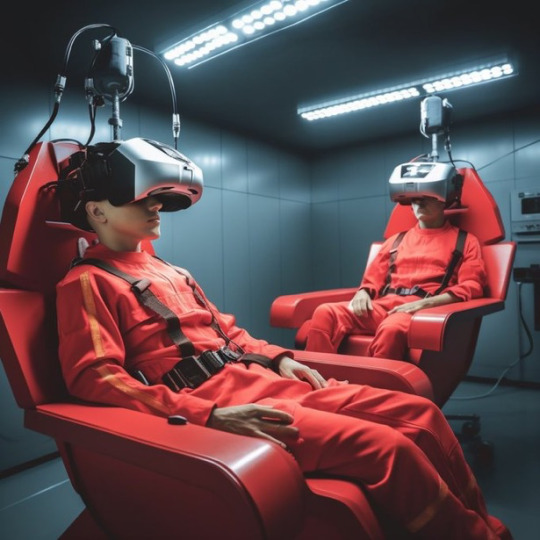
P4TZ9: “The VR environments we are immersed in allow us to practice and refine our skills in realistic emergency scenarios. While the benefits of this training approach are undeniable, the prolonged exposure to virtual realities can sometimes leave us feeling disconnected”

“The use of DBS learning technologies involves the stimulation of specific brain regions to enhance cognitive functions and accelerate learning. By targeting neural pathways associated with critical decision-making and medical knowledge retention”
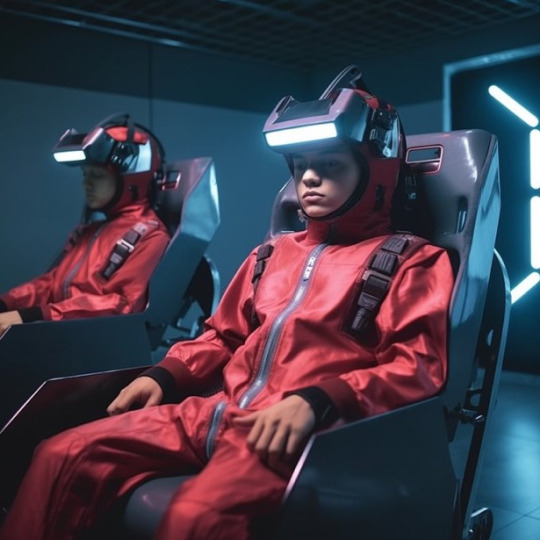
“To ensure the safety and well-being and effectiveness of the training program, the new paramedics are not allowed to leave to leave the training premises for the first four months. This is due the need to maintain a low stimulation environment and mitigate the potential…

negative effects of the training. It ensures that they have ample time for rest, recovery, and reflection between intense training sessions. This will help minimize the risk of mental and physical burnout.

By providing a controlled and low stimulation environment, we can maximize the effectiveness of the training program this includes dimmed light, no loud noises, bland food and strict schedules.

There's a sense of detachment that comes with it. A feeling of being disconnected from your own thoughts and emotions. “It's as if I'm on autopilot, functioning solely on the instructions and information provided.”, says IK46SL
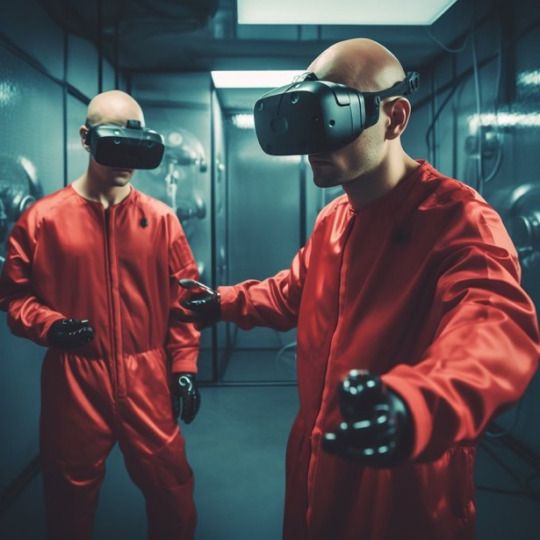
4 notes
·
View notes
Text
Exploring the Future with Granoopixr: Leading the Charge in Augmented and Virtual Reality Across India

In today’s fast-evolving digital landscape, Augmented Reality (AR) and Virtual Reality (VR) are more than just buzzwords—they’re transforming the way we live, learn, and do business. From immersive shopping experiences to virtual training simulations, the applications are limitless. At the forefront of this revolution in India is Granoopixr, a cutting-edge company pioneering innovative AR and VR solutions across cities like Delhi and Mumbai.
Whether you're a brand looking to enhance customer engagement or an institution aiming to modernize education and training, Granoopixr is your go-to augmented reality agency in India. In this blog, we’ll explore how Granoopixr is shaping the AR/VR ecosystem in India, with a special focus on its services in Delhi and Mumbai.
What is Augmented Reality and Virtual Reality?
Before diving into how Granoopixr is making an impact, let's define the basics:
Augmented Reality (AR) overlays digital content onto the real world through devices like smartphones, tablets, and AR glasses. Examples include interactive museum exhibits and AR-based shopping apps.
Virtual Reality (VR) immerses users in a completely digital environment, usually through VR headsets, for applications such as gaming, training simulations, and virtual tourism.
Both technologies offer unique advantages, and companies like Granoopixr are using them to build practical, real-world solutions.
Why Augmented Reality is Gaining Momentum in India
India, with its vast and tech-savvy population, is rapidly becoming a hub for digital innovation. AR is particularly promising in sectors like:
Retail – Virtual try-ons for fashion and home decor.
Education – Interactive AR textbooks and virtual labs.
Healthcare – AR-assisted surgeries and remote diagnostics.
Real Estate – 3D walkthroughs of properties.
This surge in interest has led to an increase in demand for augmented reality agencies in India. Granoopixr stands out among them with its deep expertise and customizable solutions.
Granoopixr: The Premier Augmented Reality Agency in India
Granoopixr is not just another tech firm—it’s a visionary company committed to bringing AR and VR into the mainstream. Here's what makes Granoopixr a top-tier augmented reality agency in India:
1. Tailored Solutions
Whether you need an AR experience for your retail outlet or a VR training module for your workforce, Granoopixr customizes its offerings to match your goals.
2. Cutting-Edge Technology
The company uses the latest AR toolkits, 3D modeling software, and VR frameworks to ensure top-notch quality and performance.
3. Cross-Industry Expertise
From education to real estate, healthcare to tourism, Granoopixr has built AR/VR experiences for diverse sectors, making them a versatile partner.
Augmented and Virtual Reality in Delhi: Granoopixr’s Capital Impact
Delhi, being the political and commercial hub of India, offers enormous potential for AR/VR deployment. Granoopixr is actively working with businesses and institutions in Delhi to drive innovation.
Key AR/VR Use Cases in Delhi:
Education: Granoopixr has collaborated with schools and universities in Delhi to create immersive AR-based learning modules that improve engagement and retention.
Events and Exhibitions: The company delivers stunning AR installations and VR experiences at trade shows and expos held in Delhi.
Government Projects: With the government’s push toward digitalization, Granoopixr is involved in smart city projects incorporating AR for navigation and real-time information systems.
So if you're looking for Virtual Reality in Delhi or Augmented Reality in Delhi, Granoopixr is the name to trust.
Virtual and Augmented Reality in Mumbai: Transforming the Business Capital
As the financial heartbeat of India, Mumbai presents limitless opportunities for AR and VR applications. Granoopixr’s presence in Mumbai is helping major brands revolutionize their customer engagement strategies.
Key AR/VR Applications in Mumbai:
Retail and E-Commerce: Granoopixr helps fashion and electronics brands in Mumbai integrate AR-powered virtual try-ons and product demos.
Media and Entertainment: With Bollywood at its core, Mumbai is a hotspot for VR filmmaking and AR promotional events, where Granoopixr plays a crucial role.
Real Estate: Property developers in Mumbai are increasingly using VR walkthroughs and AR models designed by Granoopixr to showcase their offerings.
For businesses aiming to lead with Virtual Reality in Mumbai or embrace Augmented Reality in Mumbai, partnering with Granoopixr ensures world-class outcomes.
What Sets Granoopixr Apart?
In a market flooded with generic solutions, Granoopixr’s focus on innovation, quality, and customer-centric design sets it apart. Here's how:
Scalable Solutions: From startups to large enterprises, Granoopixr delivers AR/VR solutions that scale as your needs grow.
User-Friendly Design: Their experiences are intuitive, visually rich, and optimized for real-world users.
Support and Maintenance: Granoopixr ensures that your AR/VR experiences are always up-to-date and functional.
Whether you're in Delhi, Mumbai, or any other part of India, Granoopixr’s team of developers, designers, and strategists work seamlessly to deliver excellence.
Future of AR/VR in India: Granoopixr’s Vision
As 5G connectivity and AI technologies mature, the future of AR and VR in India looks brighter than ever. Granoopixr envisions a future where:
Students across India learn with holograms and interactive simulations.
Patients consult with doctors using remote VR clinics.
Travelers explore destinations in virtual reality before booking their trips.
The company is investing in R&D, talent development, and partnerships to lead this next wave of innovation.
Conclusion: Granoopixr is Your Gateway to the AR/VR Future
The digital world is evolving—and with it, the way we communicate, shop, learn, and entertain ourselves. Granoopixr, as a leading augmented reality agency in India, is not just keeping pace but setting the trend. From Virtual Reality in Delhi to Augmented Reality in Mumbai, their impact is national, and their vision is global.
If you're ready to embrace immersive technology and redefine your digital presence, Granoopixr is the partner you need.
Looking to start your AR or VR project? Contact Granoopixr today and bring your vision to life!
#augmented reality india#augmented reality agency in india#Virtual Reality in Delhi#Augmented Reality in Delhi#Virtual Reality in Mumbai#Augmented Reality in Mumbai
0 notes
Text
How AR/VR Simulations Are Reshaping Fitness Training in 2025
In 2025, the world of fitness is no longer confined to the physical space of a gym. With the rapid adoption of immersive technologies, Augmented Reality (AR) and Virtual Reality (VR) have taken center stage, offering smarter, safer, and more engaging training environments. From enhancing personal workouts to redefining the way trainers deliver sessions, AR/VR is not just an upgrade — it’s a paradigm shift.
The Limitations of Traditional Fitness Training
Despite the rise of fitness awareness, traditional training methods continue to face several challenges:
Lack of Personalization: Most routines don’t account for individual body mechanics or learning pace.
Limited Real-Time Feedback: Correcting posture or form often depends on the availability and attention of a trainer.
Injury Risk: Poor form and incorrect techniques can lead to long-term physical issues.
Trainer Dependency: Scaling quality training for larger groups or remote users is often difficult and expensive.
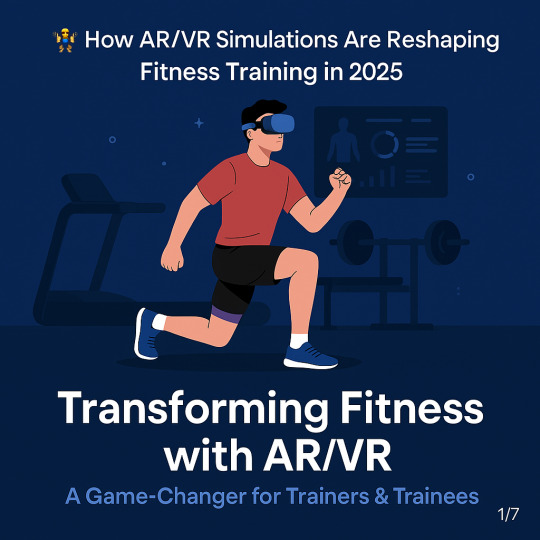
Enter AR/VR: A Game-Changer in Fitness
AR and VR technologies are not just futuristic concepts — they are actively transforming the fitness industry in 2025. Here’s how:
Simulation-Based Training: VR environments provide trainees with lifelike workout simulations, helping them experience realistic scenarios without physical risk.
Real-Time Posture Correction: AR overlays guide users on proper form, offering immediate feedback and reducing injury risk.
Immersive Learning: Users can engage with virtual instructors, gamified workouts, and scenario-driven challenges, keeping motivation levels high.
Personalized Programs: AI-driven insights adapt workouts based on user performance, goals, and physiological data.
This transformation empowers users to train smarter, recover faster, and push limits safely — whether they’re in a gym or at home.
The Tech Behind the Transformation
Behind this immersive shift lies a sophisticated ecosystem of technology:
Wearables & Sensors: Devices track movements, muscle activity, and body alignment.
VR Headsets & AR Glasses: Enable virtual simulations and augmented overlays during workouts.
Motion Capture Systems: Analyze joint and muscle movement to assess form.
AI-Powered Analytics: Provide feedback and progress tracking in real-time.
Together, these technologies deliver a training experience that is not only interactive but also data-rich and responsive.
Real-World Impact: The Tech4Biz Solutions Case Study
At Tech4Biz Solutions, we partnered with a leading fitness provider to implement AR/VR-based training simulations. Here’s what we achieved:
The Challenge:
The fitness center wanted to:
Improve training quality without increasing staff
Reduce injury incidents among beginners
Scale training support for both on-site and remote users
Our Solution:
We deployed a simulation-based fitness environment that included:
Virtual trainers for real-time form correction
Motion sensors for posture feedback
Scenario-based training to mimic real-world exercise challenges
The Results:
40% improvement in learning curve among first-time users
30% decrease in trainer intervention during workouts
Significant increase in user satisfaction and retention
These outcomes confirmed what we believed — immersive tech isn’t replacing human trainers, it’s amplifying their reach and effectiveness.
📖 Explore the full case study here
The Business Value for Gyms & Trainers
The benefits of AR/VR go beyond the user — they drive value across the fitness ecosystem:
Increased ROI: Virtual modules can be reused and scaled across multiple branches.
Remote Training Ready: Reach clients in different geographies with consistent quality.
Upskilled Workforce: Trainers become tech-enabled guides, focusing on strategy over repetition.
New Revenue Streams: Subscription models and licensing for simulation modules.
By investing in immersive fitness, businesses stay competitive in an increasingly hybrid and digital-first fitness market.
What’s Next: Metaverse Fitness and Smart Integration
Looking forward, AR/VR in fitness is poised to evolve further:
Metaverse Workouts: Fully immersive gyms where users train together in virtual spaces.
Wearable Syncing: Deeper integration with biometric devices for real-time health insights.
AI Fitness Coaches: Virtual assistants that understand your body and goals better than a human ever could.
These innovations promise a future where fitness is more accessible, efficient, and personalized than ever before.
Conclusion
In 2025, the fusion of AR/VR with fitness isn’t just a trend — it’s a fundamental change in how we approach health and movement. For businesses, it’s a golden opportunity to innovate and lead. For users, it’s the dawn of smarter, safer training.
📩 Want to explore AR/VR for your fitness business? Visit the Tech4Biz Solutions case study or contact us for a custom consultation.
#tech4bizsolutions#ar/vr development#ARinFitness#VRTraining#ImmersiveFitness#FutureOfFitness#FitnessTechnology#SmartTraining
0 notes
Text
Technology & Innovation Trends in 2025: A New Era of Transformation
As we move deeper into 2025, the world continues to experience rapid advancements in technology and innovation. These changes are reshaping industries, transforming everyday life, and creating new opportunities for businesses and individuals alike. From artificial intelligence to quantum computing, the trends we’re witnessing are no longer on the horizon—they’re here, and they’re accelerating.
1. AI Agents and Autonomous Systems
Artificial intelligence has evolved far beyond simple automation. In 2025, we're seeing the rise of AI agents—autonomous software entities capable of executing tasks with minimal human input. These agents are increasingly being used in fields like legal services, supply chain management, and customer support. Unlike static AI models, agents can plan, learn from their environment, and carry out complex sequences of actions independently. This development is especially significant in enterprise settings, where AI agents can reduce costs and boost operational efficiency.
2. Synthetic Workforce
The concept of a synthetic workforce is no longer science fiction. With advancements in robotics and machine learning, AI-driven robots are taking on roles that once required human dexterity, decision-making, and adaptability. In logistics, for instance, robots can now navigate complex warehouse environments and handle delicate packaging. In agriculture, autonomous drones and harvesters are improving yields and reducing labor costs. This shift is transforming the labor market and pushing businesses to invest in human-machine collaboration strategies.
3. Quantum Computing Gains Traction
Quantum computing has transitioned from experimental labs to commercial reality. In 2025, major tech companies are offering early-stage quantum services that promise to solve problems classical computers cannot handle—such as drug discovery, cryptography, and optimization tasks in finance and logistics. Though we're still in the “noisy intermediate-scale quantum” (NISQ) phase, breakthroughs in qubit stability and error correction suggest a future where quantum advantage becomes mainstream in select industries.
4. Mixed Reality and Spatial Computing
With the rise of devices like Apple Vision Pro and Meta’s latest headsets, mixed reality (MR) is becoming more practical. MR, which blends physical and digital environments, is being adopted in education, manufacturing, design, and healthcare. In corporate training, immersive simulations help employees gain real-world experience without real-world risk. In retail, MR offers virtual product try-ons and showroom experiences that reduce return rates and improve customer satisfaction.
5. AI-Optimized Energy Grids
To address climate change and energy inefficiency, 2025 is seeing the rollout of smart grids enhanced with AI. These grids dynamically manage electricity distribution based on real-time demand and supply, integrating renewable sources like solar and wind more effectively. AI algorithms can also detect faults before they cause blackouts, improving grid resilience and sustainability. This is a crucial development for cities aiming to reduce carbon emissions and meet sustainability targets.
6. Synthetic Biology in Manufacturing
A lesser-known but impactful trend is the rise of synthetic biology in industrial applications. Instead of using petrochemicals, companies are engineering microbes to produce everything from textiles to biodegradable plastics. This innovation has profound implications for reducing waste, lowering carbon emissions, and creating a circular economy. Startups in this field are attracting significant venture capital as consumers and regulators alike demand greener alternatives to traditional manufacturing.
7. Digital Identity and Decentralized Systems
The need for secure and portable digital identities is becoming critical as more services move online. In 2025, blockchain-powered self-sovereign identity (SSI) systems are being adopted for everything from healthcare access to voting and financial transactions. These systems give users control over their personal data, reducing the risks of identity theft and centralized data breaches.
Conclusion
The technology and innovation trends of 2025 are defining a new digital era—one where AI agents, quantum computing, and immersive realities are not just possibilities but operational realities. Businesses that stay informed and adaptable will be better equipped to thrive in this fast-changing environment. At the same time, these advancements call for thoughtful governance, ethical oversight, and societal dialogue to ensure technology serves humanity, not the other way around.
0 notes